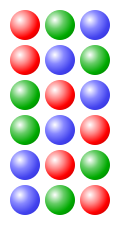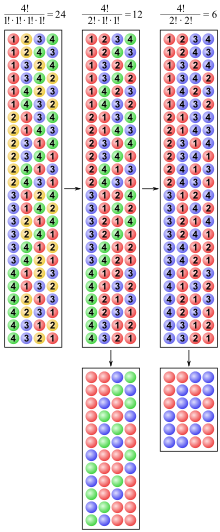Permutation
In combinatorics, a permutation (from the Latin permutare 'to interchange') is an arrangement of objects in a certain order. Depending on whether some objects may occur more than once or not, one speaks of a permutation with repetition or a permutation without repetition. The number of permutations without repetition is given as a factorial, while the number of permutations with repetition is given by multinomial coefficients.
In group theory, a permutation without repetition is a bijective self-mapping of a usually finite set, usually using the first natural numbers as reference sets. The set of permutations of the first 

Important characteristics of permutations are their cycle type, their order and their sign. With the help of the error states of a permutation, a partial order can be defined on the set of permutations of fixed length. Using their inversion table, each permutation can also be assigned a unique number in a factorial-based number system. Important classes of permutations are cyclic, fixed point free, self-inverse and alternating permutations.
Permutations have many applications within and outside mathematics, for example in linear algebra (Leibniz formula), analysis (rearrangement of series), graph theory and game theory, cryptography (encryption methods), computer science (sorting methods) and quantum mechanics (Pauli principle).

All six permutations of three colored balls
Combinatorial basics
Problem
A permutation is an arrangement of objects in a particular order or a rearrangement of objects from a given order. Examples of permutations are:
- An anagram is a permutation of the letters of a word, such as ENKEL and NELKE.
- Shuffling the cards of a deck results in a (ideally) random permutation of the cards.
- In volleyball, the change of position after conquering the right of serve is a cyclical permutation of the players.
- Many sorting methods work with successive transpositions, i.e. permutations that swap exactly two objects.
If not all objects are selected in such an arrangement, one speaks of a variation instead of a permutation; if the order does not play a role in the selection, one speaks of a combination. In counting combinatorics, the question now arises as to the number of possible permutations. Here we distinguish the case in which all objects are different from the case in which some of the objects are identical.
Permutation without repetition
A permutation without repetition is an arrangement of 




indicated.
For example, there are 
Permutation with repetition
A permutation with repetition is an arrangement of 




Given. If there are not only one, but 



specify.
For example, there are 

Algorithms
A number of algorithms exist for the systematic generation of all permutations of n elements, which can often be well formulated recursively. These include, among others, the Steinhaus-Johnson-Trotter algorithm and the heap algorithm.

Permutations of four colored spheres without repetition (left) and with repetition (middle and right).
Definition
Let 



which assigns to each element of the set an element of the same set. Clearly, by permutation, each element 




Since, by definition, any finite set to a set of the form {1, 2, ..., n} is equipotent, one can always restrict the mathematical consideration of permutations to the first 

which assigns to each natural number between 



Search within the encyclopedia



